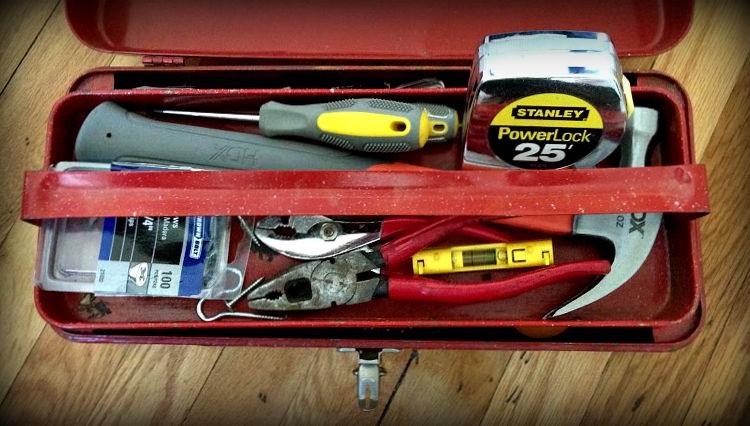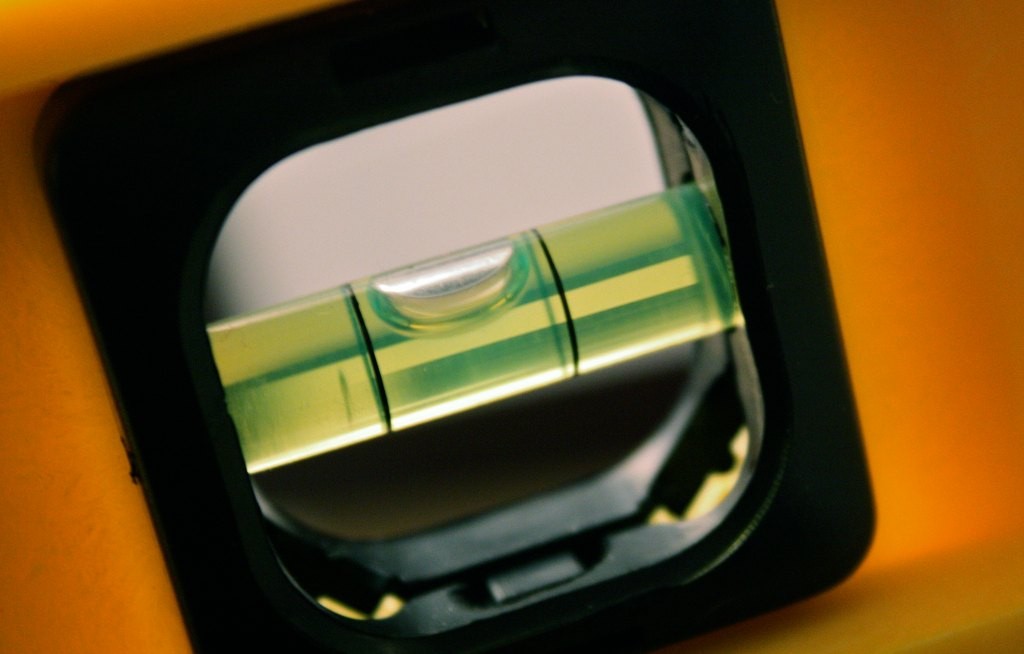A few years ago, we did a budget remodel of our gross, outdated kitchen. You can read about it here in detail, but here's a before-and-after shot to provide a visual summary: During our…

15 must-have tools for DIY homeowners
Making the leap from renting to home ownership means fixing a lot more stuff on your own — and that’s not to be feared. It’s actually awesome in many ways.
You might be surprised by how quickly you grow to enjoy the very visible, tangible reward of repairing and building things with your own hands.
I used to be useless with tools. Now I’m enthralled by them. On my birthday, I treated myself to a simple joy: Leisurely strolling the aisles at Home Depot — without a toddler to entertain or a commitment to rush off to. I spent nearly two hours slowly pacing the concrete floors, wistfully checking out tools, hardware, and lumber, and soaking in the possibilities of all the stuff I could do.
But as much as I want to buy everything in the store, a lot of it is unnecessary or simply wishful thinking for the average homeowner. Take nail guns, for instance: They’re pretty awesome, but you can probably get by without one.
The DIY homeowner’s toolbox: 15 must-have tools
Here, however, are 15 essential tools that every homeowner should keep in their toolbox or garage. Some of them you may own already, others you probably don’t. And a few of them can make great housewarming gifts, too.
Hammer and nails
We’re starting with the basics here — you’ve probably had a hammer kicking around since your first college apartment. You’ll need it handy for a lot of ongoing simple jobs, from hanging picture frames to resealing paint cans, not to mention the more complicated stuff.
You’ll also want some assorted sizes of nails on hand for all kinds of purposes. Small ones for hanging stuff, finish nails when you don’t want to see much of the nailhead, galvanized nails for outdoor projects (where you don’t want them to rust), and old-fashioned ‘bright common’ nails for everything else.
Level
Speaking of hanging pictures, a level is crucial — especially in an old house where floors and walls tend to get a little wavy over the years. Installing cabinets, countertops, shelves, or even a towel rack all require a level.
You should also check that appliances such as your fridge and washer are level, as even a slight tilt can affect their performance. I find a simple 24-inch level is just the right size for most tasks, but a longer one is helpful when installing a run of cabinets.

Photo by Anne Swoboda
Screwdrivers and screws
There’s no need to get one of those combo packs with 30 different-sized screwdrivers. You’ll be better served by just a couple good-quality screwdrivers in the most common sizes: a couple Philips-heads (#1 and #2) and a couple 1/4″ flat-heads. Find ones you like, and buy a few of them — a pair for the kitchen, a pair for the garage, and a pair for your toolbox.
You want them slightly magnetized if possible — to help you from losing small screws — and you want the tips to be treated so they don’t start stripping away after prolonged use.
Even better is a good multi-bit screwdriver, like this one or this one, which allow you to swap between Phillips head or flat-head bits using the same handle and have a ratcheting mechanism so each turn counts. But you still may want one on each floor of the house — and make sure you stay organized so you don’t lose the bits.
As for screws, you can’t go wrong with 1.5-inch- and 2.5-inch-long wood and drywall screws. It’s worth having some very short (half-inch) wood screws kicking around, too. And as with nails, keep a pack or two of exterior (galvanized) screws on hand for outdoor projects.
Good corded drill + drill bits
Here’s a secret: Cordless drills are a rip-off for most of us. The batteries alone cost more than a good corded drill, and many of them still struggle to produce the power a corded connection affords. Plus, you have to make sure to keep them charged religiously so they’re ready when you need them. Then, they thank you by crapping out after a few years, and you’ve got to buy expensive replacements.
Cordless drills are undeniably handy — for some situations. But are you planning on building a model home on an empty tract of land, or building a tree house deep in the forest? No. You’ll be drilling stuff in your house, or in your garage workshop, or even in your backyard — all of which are in easy reach of an electrical outlet or an extension cord. Don’t feel like you need to waste extra money on a cordless drill.
Here’s what to get: A simple, powerful corded drill (7 amps or more), with a half-inch chuck to handle larger drill bits, and variable speed so you can apply some finesse when necessary. Done.
The drill should come with a heavy-duty screwdriver bit. To round it out, get a set of assorted drill bits, and pick up a few specialty bits and extras of the ones you’ll use (or lose) most often.
The small 1/16″ and 1/32″ bits often break, and you’ll inevitably lose a few over time as you jockey between the drill bits and screwdriver bits. Meanwhile, some helpful specialty bits include countersink bits (which carve out a little divot for the head of the screw so it ends up nice and flush with the wood) or masonry bits that can drill into concrete or brick.
Extension cords
Owning a corded drill means you’re going to need to plug it in. And sometimes what you’re drilling is just out of reach of the nearest outlet.
That’s especially true when you live in an old house like ours, where there are never enough outlets. We had a total of one wall outlet in our bedroom before we added a second one. Just one!
Of course, you’ll use extension cords for much more than drilling. I use them outside for the lawn mower, leaf blower, weed whacker, various saws, the wet/dry vac… you name it.
Rather than a long, heavy, 100-foot cord that will just get tangled up, I prefer having a few 25- for 50-foot outdoor cables with medium- to heavy-gauge wire (the smaller the number, the thicker and stronger the wire — so a 14-gauge wire can transfer more current than a 16-gauge one). For indoor use, you really only need a couple of nine-foot cords.
Circular saw
If you’re going to own just one saw — and that’s a good place to start — this is the best all-round, all-purpose saw to have. With a good circular saw, you can make all basic cross cuts, plus cut at an angle like a miter saw would, or even rip cut a long board like you would on a table saw (without the same ease or precision, but still — it’ll work).
Clamps
In order to make a long, straight cut with a circular saw, though, you’ll need to clamp down a straight-edge board to act as your guide. You simply cannot have enough clamps lying around, in all different sizes.
Toilet auger and/or plumbing snake
Most skilled tradespeople charge upwards of $60 an hour for their time, and charge a minimum of two hours for a service call. In desperation, I recently paid $130 for a plumber to come unclog a toilet; he was in our house for all of 90 seconds.
NINETY. SECONDS.
That’s because he had a tool I didn’t, called a toilet auger. It costs like $30, and it can unclog even an extremely stubborn toilet in just minutes.
It’s easy to use, too: Just plunge it down into the toilet drain, and keep turning the crank so the auger drills through the clog and breaks it up.
Obviously, I own one now.
I’ve always had a plumbing snake, which is well worth the price at $25-$35. That little gizmo has saved me from other emergency calls, and with a 25-foot reach it can dive deep into your pipes. But it wasn’t powerful enough to handle this beastly backed-up toilet. (I should add — that was in our rental unit. I wasn’t the clogger!)
Long-nose pliers
I can’t count the number of times I’ve needed a pair of needle-nose pliers for some ridiculous task — like pulling the base of a broken light bulb out of a light fixture, for instance — and haven’t been able to find them.
Because I’m always using them, often in weird situations or places, they don’t always end up back in the toolbox. I need to talk to myself about that, it’s super annoying! But anyway, needle-nose or long-nose pliers give you the equivalent of super-strong, tiny fingers, which are essential for a hundred different tasks around the house.
Adjustable wrench
Your average homeowner doesn’t need a full 100-piece ratchet and wrench set. For general purpose use around the house, a single pair of slip-joint pliers or a large adjustable wrench will do the job 95% of the time.
Stud finder
Stud finders are magic: They can help you locate the wood studs (vertical support beams) that are otherwise hidden behind the wall.
This sounds like something you’d only need when doing a pretty major remodeling job — and you certainly need one in that case. But a stud finder is awesome for one of the most common, easy DIY projects out there: hanging shelves.
Installing shelves is very straightforward, but it can also go catastrophically wrong. How? Let’s say you’re hanging a corner shelf in the bathroom. If you drill a screw into the wall to mount the shelf and accidentally puncture a water pipe, heat pipe — or yuck, a sewage pipe — you have just created a serious problem! (What’s worse, you may not even realize it for months, because the screw can form a tight seal in the pipe — until it starts to rust away and the never-ending leak begins!)
So how does a stud finder help? The better ones (wall scanners) can alert you to pipes and wires hiding behind the wall, which is super helpful. (Drilling into live wires is also bad news!)
But for the most part, even a simple one works — because by process of elimination, drilling into a wood stud means you’re not drilling into something else. And if you want your shelf to hold anything fairly heavy, like glass jars or books, you should really secure it to the studs.
Tape measure
You should have a tape measure by now, but if you don’t, get one. You won’t get very far with any DIY project without one.
Handsaw & hacksaw
You don’t always want to bust out a circular saw — and its screaming-loud motor — for one simple wood cut, so an old-school handsaw is great to have around.
More importantly, sometimes you need to cut through metal or other material. A hacksaw can do that for you, in a process that seems, at least to me, like some kind of dark magic. It lets you CUT THROUGH METAL!
Tape
If McGuyver taught us anything, it’s that duct tape can save your butt in a pinch. This is no less true around the house. And don’t skimp on duct tape — I’ve tried, and it doesn’t stick as well. Get the good stuff.
Same goes for electrical tape, masking tape, and plumbing tape, three more must-haves for many situations. Got a nick in your extension cord? Wrap it with electrical tape. Masking tape, or painter’s tape — which won’t peel paint off your walls — is helpful in any number of uses. And when threading pipes together, wrap plumber’s tape around the threads to make a perfect, tight seal.
Wet/dry vac
We’ve had our Rigid wet/dry vac since we first moved in. It sucks up dry stuff, and it sucks up wet stuff, too, all for like $49. If you spill, say, a bowl of soup on a wood floor, it can suck up the whole damned thing. What more can I say about this little miracle of modern suction?
I’m sure I’ve missed a few, but that should be enough to get you started in your new home. Of course, depending on what kind of projects you take on around the house, there are hundreds more awesome tools to add to your collection, from a combination square to a compound miter saw.
Get started with these 15 basics, and then pick up more job-specific tools as you go — for instance, pick up paint rollers once you’re ready to give the spare bedroom a new look.
In almost every case, having the right tool for the job can be the difference between a frustrating failure and a satisfying success.



